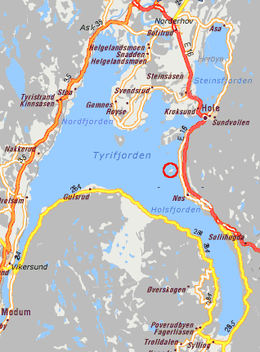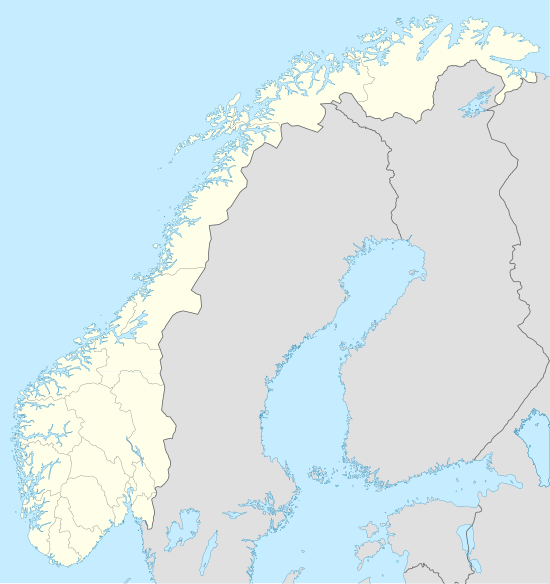Utøya
 Detailed map of Tyrifjorden, with Utøya encircled in red | |
 | |
| Geography | |
|---|---|
| Location | Tyrifjorden |
| Coordinates | 60°01′25″N 010°14′53″E / 60.02361°N 10.24806°ECoordinates: 60°01′25″N 010°14′53″E / 60.02361°N 10.24806°E |
| Area | 0.106 km2 (0.041 sq mi) |
| Administration | |
Utøya (Norwegian pronunciation: [ˈʉːtœʏɑ]) is an island in the Tyrifjorden lake in Hole municipality, in the county of Buskerud, Norway. The island is 10.6 hectares (26 acres),[1] situated 500 metres (1,600 ft) off the shore, by the E16 road, about 20 km (12 mi) driving distance south of Hønefoss, and 38 km (24 mi) northwest of Oslo city centre.
Overview
Utøya is owned by the Workers' Youth League (AUF), a youth group associated with the Labour Party, which holds an annual summer camp there.
The island is operated commercially by Utøya AS.[2]
The island is largely forested, with some open spaces. A small pier on the east side of the island is used to ferry people to and from Utøykaia on the mainland. There are also permanent buildings. Hovedhuset ("The Main House"), Stabburet ("The Hórreo"), and Låven ("The Barn") are located together near the dock. Up on the hillside (LO-toppen) are the main campgrounds, the cafeteria building, and the sanitary building. Skolestua ("The school house") is located further south.[3]
The name
The first element ut means 'out', or 'outermost'; the last element øya is the definite form of øy, meaning 'island'. Utøya is the southernmost (or farthest "out") island of three which lie in the lake of Tyrifjorden. The name is used in reference to its position in relation to two other islands (lying north of Utøya); Storøya (Big Isle) and Geitøya (Goat Isle). Storøya is the northernmost, and Geitøya lies between Utøya and Storøya. All of these islands were formerly used for herding (as is shown in the meaning of Geitøya) by the people at Sundvollen. Utøya is quite clearly connected to the name of Utvika on the shoreside.
History
The island was a croft until purchased by Jens Bratlie in 1893. Bratlie used the property as a summer residence until 1933 when it was purchased by Trade Union Confederation.[4]
The island was given as a commemorative gift by Oslo Trade Union Confederation on 28 August 1950,[5] and it has hosted several political organizations' summer camps.
2011 massacre
On 22 July 2011, a mass shooting took place at the AUF's summer youth camp, where 650 young people were staying. Anders Behring Breivik arrived alone on Utøya dressed as a police officer and told those on the island that he was there for security reasons following the explosions in Oslo which took place a few hours before. He then began shooting at individuals, continuing until the police arrived one hour after the first alarm call. The suspect immediately surrendered.[6] Combined, the attacks in Oslo and Utøya left 77 dead, with 69 killed on the island, 33 of whom were under the age of 18.[7][8][9]
The massacre at Utøya remains the deadliest shooting worldwide committed by a single gunman.
After the massacre
"Rapidly it became clear, that ... [the bereaved] needed more time. [Construction work, or] The construction was put on hold for two years", according to the island's manager (as of 2016), Jørgen Frydnes.[10]
After the attack, several donations were given to AUF for the restoration of the island. Some of the buildings would be demolished, including [parts of] the cafeteria building where 13 people had been killed;[11] some of the buildings have been demolished, as of 2016.
With some disagreement having been bridged (as of 2016) - the future of Utøya has been the source of disagreements among the victims and family of the attacks. While AUF's planned to [rapidly] rebuild and return to Utøya, others wanted to leave the island as a memorial to the dead.[12]
Places and buildings
Bays on the island's coastline include Bolsjevika.[13]
There are paths including Kjærlighetsstien ([lovers' lane or]"the love path").[13]
A hill - "used by discussion [groups]" leads to [a barn, according to its name,] Arbeidsmiljølåven.[13] Other buildings are "the café building" and the pump house.[13]
["The hill"] "Bakken" is used by the audience of speeches (as of 2016).[14]
Memorial place
The place of memorial is called ["the clearing"] Lysninga;"it lies at the highest point of the island";[15] It was unveiled during the summer of 2015.[16][17]
Components of the memorial place include ["the ring"] "Ringen" - a "ring of steel [that] hangs between trees and here the names and age[13] of the majority of those 69 killed are engraved".
"The ring" weighs one (metric-) ton; one part of it weighs 350 kilograms; Alice Greenwald gave advice about leaving some space on "the ring", so that some of the bereaved can later change their mind - so that their deceased relative's name is permitted to be engraved on "the ring".[10]
Hegnhuset ("safeguard house")
Hegnhuset - consists of "Parts of the café building (kafébygget ) ..., where 13 people were killed ..., [that] have been preserved (as of 2016); around- and under the café building - a ["learning center"] læringssenter" has been created;[13][18][19] 69 columns support the roof,[13] inside the glass walls (of the exterior of the building).[20] 495 "safeguarding" planks - positioned vertical in the ground - enclose the building; with space - svalgang - between the planks and the building.[20]
"The house will protect the memory of the 69 who were killed at Utøya", a father (of one of the massacre's survivors) wrote in a news article.[13]
Etymology: The building has been named Hegnhuset - "a place that shall safeguard (hegne) democracy".[21] A synonym of hegn is the imperative form of the verb "safeguard"; therefore Hegnhuset can mean "safeguard house" (with the determinate conjugation of "house").
Inside the café building, preserved (as of 2016) are bullet holes in walls, "the open windows where several youths jumped out to escape" the murderer; an old chart (that was there in 2011) that says "you must know the past, to understand the present and peer into the future", and pictures of dead victims; at least one heart-shaped stone, with the inscription "Missing you [singular]", lies on the floor.[22]
In lillesalen ("the small hall") there is a piano; one was there during the crime. Court testimony has indicated that persons hiding behind the piano on 22 July 2011, were shot.[23]
References
- ↑ Coastline for the property "0612-235/1 Utøen", according to Statens kartverk, http://seeiendom.no/
- ↑ "''Utøya 2010 – AUFs summer camp'' (Arbeidernes Ungdomsfylking". Auf.no. Archived from the original on 4 September 2011. Retrieved 2011-07-23.
- ↑ "Massakren på Utøya (Annotated photo of Utøya)". Haugesunds Avis/Nyhetsgrafikk. Retrieved 24 July 2011.
- ↑ Bergens tidende magasinet 21.juli 2012 s.13.
- ↑ Store Norske Leksikon: Utøya Retrieved 2011-07-24
- ↑ "VGs fotograf havnet midt i bombedrama - hjelper skadede barn". Verdens Gang (in Norwegian). 24 July 2011. Retrieved 24 July 2011.
- ↑ Gibbs, Walter (2011-03-31). "At least 93 dead in Norway shooting, bomb attack | Reuters". Uk.reuters.com. Retrieved 2011-07-23.
- ↑ "Norway police lower youth camp death toll to 68". The Atlanta Journal-Constitution. 25 July 2011. Retrieved 25 July 2011.
- ↑ Terrorofrene på Utøya og i Oslo
- 1 2 Astrid Hauge Rambøl (22 July 2016). "Med Utøya som arbeidsplass". Klassekampen. pp. 28–9.
- ↑ "Har fått inn 35 millioner kroner på Utøya-fond" (in Norwegian). VG. 2 May 2012. Archived from the original on 18 May 2012. Retrieved 30 July 2012.
- ↑ Johnsrud, Nina (5 July 2012). "Splittet om Utøyas framtid" (in Norwegian). Dagsavisen. Retrieved 30 July 2012.
- 1 2 3 4 5 6 7 8 Kjell-Erik Nordenson Kallset (1 July 2016). "Tar tilbake Utøya". Klassekampen. p. 2.
- ↑ http://www.dagsavisen.no/innenriks/den-nye-generasjonen-utoya-1.761767
- ↑ Publisert 19.07.2016, kl. 05.31. (2016-07-19). "50 turer dagen til Utøya på det meste". Nrk.no. Retrieved 2016-07-24.
- ↑ Gabrielle Graatrud (2016-06-18). "Etterlatte frykter at 22.juli-minnestedet blir en bauta over gjerningsmannen". Dagbladet.no. Retrieved 2016-07-24.
- ↑ "No shame in turning around!". Dagbladet.no. Retrieved 2016-07-24.
- ↑ "Kafébygget på Utøya åpnes igjen". Vg.no. 2016-07-19. Retrieved 2016-07-24.
- ↑ "Hegnhuset symboliserer de drepte på Utøya". Nrk.no. 2016-07-18. Retrieved 2016-07-24.
- 1 2 "Nødvendigheten og minnene". dagsavisen.no. Retrieved 2016-07-24.
- ↑ Åshild Lappegård Lahn (18 July 2016). "Vil hindre at det skjer igjen". Klassekampen.
- ↑ "Kafébygget på Utøya åpnes igjen - VG". Vg.no. 2016-07-19. Retrieved 2016-07-24.
- ↑ Av Per Erik Hagen. "Breivik husket ikke skyting i Lillesalen på Utøya". Budstikka.no. Retrieved 2016-07-24.
External links
| Wikimedia Commons has media related to Utøya. |